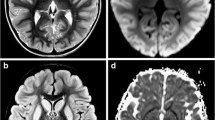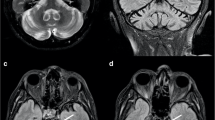Abstract
We examined five males with laboratory-confirmed ataxiatelangiectasia (AT), aged 9–28 years, several times by MRI (9 examinations: 5 at 0.15 T, 3 at 0.5 T, 1 at 1.5 T). Intermediate, T1-, T2-and T2*-weighted spin-echo and gradient-echo sequences were performed. All patients showed vermian atrophy, enlarged fourth ventricle and cisterna magna; four showed cerebellar hemisphere atrophy; two enlarged infracerebellar subarachnoid spaces and four patients had sinusitis. No focal areas of abnormal signal were seen in the brain, diffuse high signal was found in the central cerebral white matter of the oldest patient. AT is an important human model of inherited cancer susceptibility and multisystem ageing; as in xeroderma pigmentosum and other “breakage syndromes”, ionising radiation should be avoided. When imaging is necessary, MRI should be preferred to CT in patients known or suspected to have AT and those with undefined paediatric ataxias of nontraumatic origin. If atrophy of only the cerebellum, especially the vermis, is noted, laboratory research should be performed to confirm the diagnosis of AT.
Similar content being viewed by others
References
Syllaba L, Henner K (1926) Contribution a l'independance de l'athétose double idiopathique et congénitale. Atteinte familiale, syndrome dystrophique, signe du réseau vasculaire conjunctival, intégrité psychique. Rev Neurol 1: 541–562
Louis-Bar D (1941) Sur un syndrome progressif comprenant des télangiectasies capillaires cutanées et conjunctivales symmétrique, à disposition naevoide et de trouble cérebelleux. Confin Neurol 4: 32–42
Boder E, Sedgwick RP (1957) Ataxiatelangiectasia. A familial syndrome of progressive cerebellar ataxia, oculocutaneous telangiectasia and frequent pulmonary infection. A preliminary report on 7 children, an autopsy and a case history. USC Med Bull 9: 15–28
Boder E, Sedgwick RP (1958) Ataxiatelangiectasia. A familial syndrome of progressive cerebellar ataxia, oculocutaneous telangiectasia and frequent pulmonary infection. Pediatrics 21: 526–554
Boder E (1985) Ataxia-telangiectasia: an overview. In: Gatti RA, Swift M (eds) Ataxia-telangiectasia: genetics, neuropathology, and immunology of a degenerative disease of childhood. Liss, New York, pp 1–63
McKusick VA (1991) Mendelian inheritance in man, 9th edn. John Hopkins University Press, Baltimore
Gatti RA (1991) Localizing the genes for ataxia-telangiectasia: a human model for inherited cancer susceptibility. Adv Cancer Res 56: 77–104
Timme TL, Moses RE (1988) Review: diseases with DNA damage-processing defects. Am J Med Sci 295: 40–48
Swift M, Morrell D, Cromartie E, Chamberlin AR, Skolnick MH, Bishop DT (1986) The incidence and gene frequency of ataxia-telangiectasia in the United States. Am J Hum Genet 39: 573–586
Gatti RA, Boder E, Vinters HV, Sparkes RS, Norman A, Lange K (1991) Ataxia-telangiectasia: an interdisciplinary approach to pathogenesis. Medicine 70: 99–117
Waldmann TA, McIntire KR (1972) Serum-alpha-fetoprotein levels in patients with ataxia-telangiectasia. Lancet II: 112
Sugimoto T, Savada T, Tozawa M, Kidowaki T, Kusunoki T, Yamaguchi N (1978) Plasma levels of carcinoembryonic antigen in patients with ataxia-telangiectasia. J Pediatr 92: 436–439
McFarlin DE, Strober W, Waldmann TA (1972) Ataxia-telangiectasia. Medicine 51: 281–314
Oppenheimer DR (1984) Diseases of the basal ganglia, cerebellum and motor neurons. In: Adams JH, Corsellis JAN, Duchen LW (eds) Greenfield's neuropathology. Wiley, New York, pp 724–726
Sedgwick RP, Boder E (1972) Ataxiatelangiectasia. In: Vinken PJ, Bruyn GW (eds) A handbook of clinical neurology. North Holland, Amsterdam, pp 267–339
Gatti RA, Good RA (1971) Occurrence of malignancy in immunodeficiency diseases. Cancer 28: 89–98
Morrell D, Cromartie E, Swift M (1986) Mortality and cancer incidence in 263 patients with ataxia-telangiectasia. J Natl Cancer Inst 77: 89–92
Swift N, Sholman L, Perry M (1976) Malignant neoplasms in the families of patients with ataxia-telangiectasia. Cancer Res 36: 209–215
Levine C, Vrlenich L (1989) Renal lymphoma in ataxia-telangiectasia: CT contribution. J Comput Assist Tomogr 13: 537–539
Stoppa-Lyonnet D, Aurias A (1992) Ataxia télangiectasie: quel impact en cancérologie clinique? Bull Cancer 79: 645–650
Hecht F, Kaiser-McGraw B (1982) Ataxia-telangiectasia. In: Bridges BA, Harnden DG (eds) Ataxia-telangiectasia. Wiley, New York, pp 197–201
Jaspers NG, Bootsma D (1982) Genetic heterogeneity in ataxia-telangiectasia studied by cell fusion. Proc Natl Acad Sci USA 79: 2641–2644
Biemond A, Van Bolhuis JH (1959) Atrophia cerebelli with oculocutaneous telangiectasis and bronchiectasis as a familial syndrome. Ned Tijdschr Geneeskd 103: 2253–2258
Scharnetzky M, Kohlschutter A (1980) CT findings in a case of ataxia-telangiectasia (Louis-Bar syndrome). Neuropediatrics 11: 384–387
Assencio-Ferreira VJ, Bancovsky I, Diament AJ, Gherpelli JLD, Moreira FA (1981) Computed tomography in ataxia-telangiectasia. J Comput Assist Tomogr 5: 660–661
Romanengo M (1991) Atassia-teleangiectasia: il registro nazionale. Dati preliminari. Thesis, University of Genua
Chessa L, Terracini B, Federico A, Borrone C, Gandini E (1989) Registro italiano per l'atassia-teleangiectasia. Presentazione e discussione dei primi dati. In: Patologia genetice ad esordio tandivo, Monduzzi, Bologna, pp 495–497
Byrd SE (1991) Central nervous system manifestations of inherited syndromes. In: Atlas SW (ed) Magnetic resonance imaging of the brain and spine. Raven Press, New York, p 562
Amromin GD, Boder E, Teplitz R (1979) Ataxia-telangiectasia with a 32-year survival. A clinico-pathological report. J Neuropathol Exp Neurol 38: 621–643
Agamanolis DP, Greenstein JL (1979) Ataxia-telangiectasia. Report of a case with Lewy bodies and vascular abnormalities within cerebral tissue. J Neuropathol Exp Neurol 38: 475–488
Casaril M, Gabrielli GB, Capra F, Falezza GC (1982) Atassia-teleangectasia: descrizione di un caso con emorragie cerebrali multiple e cirrosi epatica. Minerva Med 73: 2183–2188
Osetowska E, Traczynska (1964) Sur l'ataxie avec télangiectasie, une observation anatomo-clinique. Acta Neuropathol 3: 319–325
Wessel K, Schroth G, Diener HC, Muller-Forell W, Dichgans J (1989) Significance of MRI_confirmed atrophy of the cranial spinal cord in Friedreich's ataxia. Eur Arch Psychiatry Neurol Sci 238: 225–230
Braffman BH, Tojanowski JQ, Atlas SW (1991) The aging brain and neurodegenerative disorders. In: Atlas SW (ed) Magnetic resonance imaging of the brain and spine. Raven Press, New York, pp 609–615
Savoiardo M, Strada L, Girotti F, Zimmerman RA, Grisoli M, Testa D, Petrillo R (1990) Olivopontocerebellar atrophy: MR diagnosis and relationship to multisystem atrophy. Radiology 174: 693–696
Baloh RW, Yee RD, Honrubia V (1986) Late cortical cerebellar atrophy. Clinical and oculographic features. Brain 109: 159–180
Vighetto A, Froment JC, Trillet M, Aimard G (1988) Magnetic resonance imaging in familial paroxysmal ataxia. Arch Neurol 45: 547–549
Furman JM, Baloh RW, Chugani H, Waluch V, Bradley WG (1985) Infantile cerebellar atrophy. Ann Neurol 17: 399–402
Saito H, Yanagisawa T (1989) Acute cerebellar ataxia after influenza vaccination with recurrence and marked cerebellar atrophy. Tohoku J Exp Med 158: 95–103
Gotoff SP, Amirokri E, Liebner EJ (1967) Ataxia-telangiectasia: neoplasia, untoward response to X-irradiation, and tuberous sclerosis. Am J Dis Child 114: 617–625
Hecht F, Koler RD, Rigas DA (1966) Leukemia and lymphocytes in ataxiatelangiectasia. Lancet II: 1993
Cox R, Hosking GP, Wilson J (1978) Ataxia-telangiectasia: evaluation of radiosensitivity in cultured skin fibroblasts as a diagnostic test. Arch Dis Child 53: 386–390
Painter RB, Young BR (1980) Radiosensitivity in ataxia-telangiectasia: a new explanation. Proc Natl Acad Sci USA 77: 7315–7317
Waldmann TA, Misiti J, Nelson DL (1983) Ataxia-telangiectasia: a multisystemic hereditary disease with immunodeficiency, impaired maturation, X-ray hypersensitivity, and a high incidence of neoplasia. Ann Intern Med 99: 367–379
Keyse SM, McAleer MA, Davies DJG (1985) The response of normal and ataxia-telangiectasia human fibroblasts to lethal effects of far, mid and near ultraviolet radiations. Int J Radiat Biol 48: 975–985
Ejima Y, Sasaki MS (1986) Enhanced expression of X-ray and UV-induced chromosomal aberrations by cytosine arabinoside in ataxia-telangiectasia cells. Mutat Res 159: 117–123
Parshad R, Sanford KK, Jones GM (1985) G22 chromosomal radiosensitivity of ataxia-telangiectasia heterozygotes. Cancer Genet Cytogenet 14: 163–168
Morgan JL, Holcomb TM, Morrisey RW (1968) Radiation reaction in ataxia-telangiectasia. Am J Dis Child 116: 557–558
Cunliffe PN, Mann JR, Cameron AH, Roberts KD, Ward HW (1977) Radiosensitivity in ataxia-telangiectasia. J Pediatr 91: 269–271
Pritchard J, Sandland MR, Breatnach FB, Pincott JR, Cox R, Husband P (1982) The effects of radiation therapy for Hodgkin's disease in a child with ataxia-telangiectasia. Cancer 50: 877–886
Abadir R, Hakami N (1983) Ataxia-telangiectasia with cancer. An indication for reduced radiotherapy and chemotherapy doses. Br J Radiol 56: 343–345
Paller AS (1987) Ataxia-telangiectasia. Neurol Clin 5: 447–449
Harnden DG, Bridges BA (1982) Ataxia-telangiectasia. A model of cancer susceptibility. In: Bridges BA, Harnden DG (eds) Ataxia-telangiectasia. Wiley, New York, pp 3–10
Author information
Authors and Affiliations
Rights and permissions
About this article
Cite this article
Sardanelli, F., Parodi, R.C., Ottonello, C. et al. Cranial MRI in ataxia-telangiectasia. Neuroradiology 37, 77–82 (1995). https://doi.org/10.1007/BF00588526
Received:
Accepted:
Issue Date:
DOI: https://doi.org/10.1007/BF00588526




